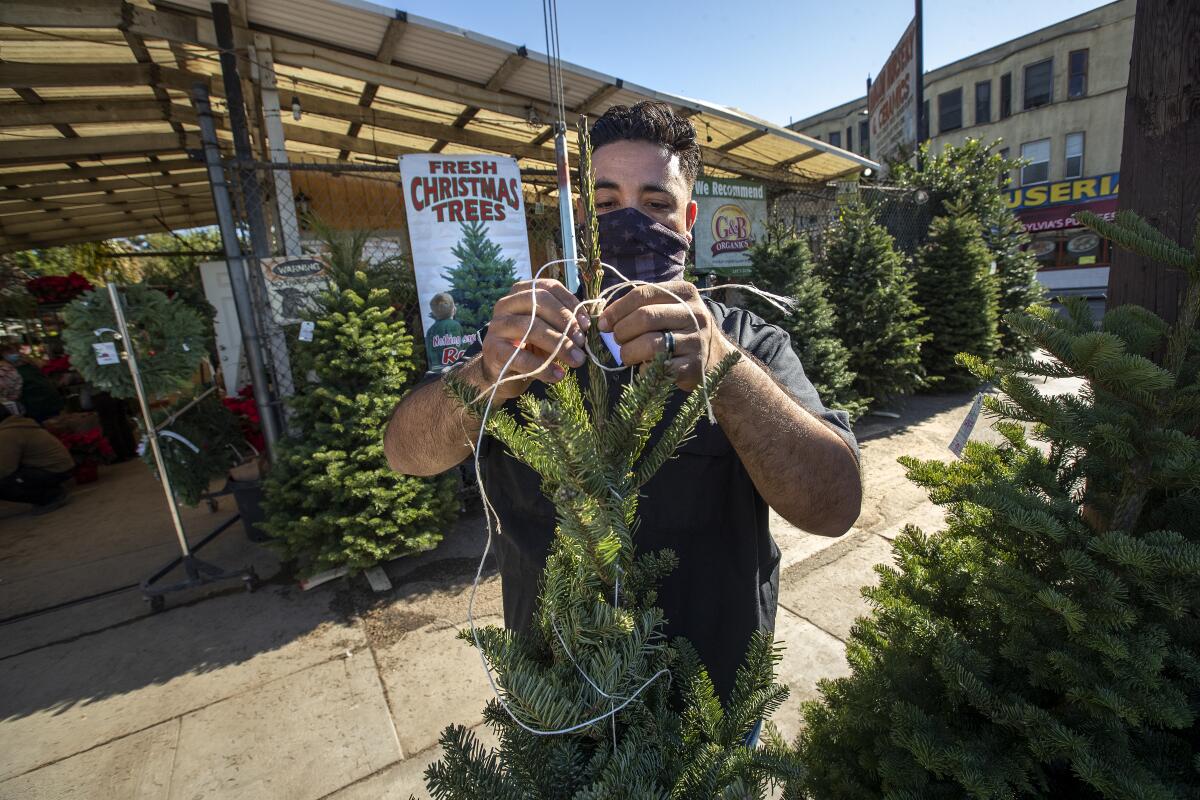How to buy a live Christmas tree

- Share via
The holiday season is here, capping off a year that has suffered from a notable lack of merriment since March.
Between battling the general lack of good cheer and facing down the prospect of spending the holidays at home, people are embracing Christmas decorations. For some, that means putting up a live tree for the first time.
“People are going crazy for Christmas,” said Mac Harman, who sold live trees for nine years before founding Balsam Hill, which sells artificial trees and holiday decorations. The Balsam Hill website’s “Christmas in July” sale saw a 50% increase compared with the previous year, he said, and demand hasn’t slowed since.
Some consider it a faux pas to decorate for Christmas before Thanksgiving, but is the stress of the pandemic turning more people into early decorators?
Brandon Helfer is the owner of Mr. Jingle’s Christmas Trees, which sells live trees at several locations around Southern California. He said he’s seen a notable increase in first-time tree buyers, particularly from people who tell him they’re staying home for the holidays this year instead of traveling to visit family.
If you’re one of the first-timers making a foray into live trees, here’s what you need to know to have the optimal evergreen experience.
Before you go
Decide whether you want to go to a lot. The business limitations from the city of Los Angeles and the state don’t specifically mention Christmas tree lots, but since they are retail and outdoors, they will likely be able to continue operation. (If that changes, we’ll update this article.) But if you’d prefer to minimize your contact with the outside world, call your local lot and inquire about delivery or curbside pickup. Helfer said he’s had an increase in both requests this year, which Mr. Jingle’s has hustled to accommodate.
“COVID forced us to really change the business model,” he said. “We try to keep that old school feel but be technologically advanced at the same time.”
You should also decide whether you want to get a precut tree from a lot or nursery or whether you want to cut one down yourself. Several farms around L.A. offer the cut-your-own-Christmas tree experience. There are lots of precut ones from family farms all around Southern California.
Want to get in the holiday spirit? These family-run tree farms allow you to choose and cut your own Christmas tree.
Whether you’re doing in-person, pickup or delivery, you’ll need to know what size tree your home can handle. Measure your ceiling height and subtract at least a foot, Harman said, so that you have space for the tree topper. Don’t forget to measure the width where the tree is going as well.
Many lots accept credit cards, though some are still cash-only. Call ahead to check or be prepared to make an ATM detour. Like everywhere else in Southern California, bring a mask and be ready to maintain at least six feet of distance from other people. You don’t need to bring twine or anything else, except maybe an old blanket to protect the top of your car.
Places like the Home Depot have trees available and offer delivery, but Helfer said big-box retailers tend to offer lower-quality trees. The best quality trees are more likely to come from independent lots that specialize in the business.
At the Christmas tree lot
In Southern California, expect to pay between $50 and $200, depending on the size and type of tree you buy. The median price of a real Christmas tree purchased in 2019 was $76.87, according to a national survey from the National Christmas Tree Assn.
The price will depend on the height and the type of tree.
Do the scent of pine and twinkling lights give you a boost? Shop for Christmas trees at these family-run tree lots.
You’ve already determined how tall your tree can be; next ask a worker which varieties the lot offers.
Most California lots will have Douglas and noble firs, which grow on the West Coast. Douglas firs are light green with fine needles; they’re typically less expensive and more fragrant. They’re also notorious for not lasting as long and shedding copious amounts of needles. Noble firs have thicker blue-green upward-growing needles and are more expensive; they will keep the Christmas cheer going longer and require less sweeping but might not have as much of that seasonal fragrance. (Thankfully, there are scented candles that can make up for that.)
Also ask when the tree was cut down. The reality is that 30 million trees cannot be cut down simultaneously the weekend before the three-week-long tree-buying season. The bulk of the workforce who chop down and transport Christmas trees are migrant workers who typically begin after grape harvesting season ends in the fall, Harman said, so the very first trees available might have been cut a few weeks earlier. You either want a tree that was cut recently or one that has been stored in the cold for preservation.
The lot might offer to make a fresh cut on your tree. If not, you’ll want a saw handy at home. In either case, leave at least 6 inches of tree trunk between the cut and where the branches start. Some places offer to add flame retardant or flocking, which makes it look like your tree was subject to a snow flurry.
If you’re a first-time tree buyer, you probably don’t have a tree stand, which will probably be sold separately at the lot. You might also be able to find wreaths and garlands, though they tend to sell out quickly. Mr. Jingle’s locations offer one-stop shopping for Christmas decorating needs, including lights, ornaments and tree skirts, though that’s not the case at all tree lots.
Once you’ve selected your tree, ask about a tree shaker. It’s a device that gives your tree a good hard shake, so that all the loose needles it would lose in the first couple of days hit the ground on the lot instead of in your living room. Not every place will have one.
Welcome to our comprehensive gift guide for the 2020 holiday season.
Wherever you get your tree, it will have twine and someone willing to help you hoist your bounty onto your car’s roof and tie it down. This is where having an old blanket to put down first comes in handy, though it isn’t necessary. Be sure to tip.
Back at home
Once you get the tree and the stand inside, it’s time to set it up. Some tree stands have a spike in the middle on which to impale the tree; others use adjustable bolts or fasteners to hold it upright. Optimally, Harman said, you’d have one person holding up the tree, one person crawling under it to adjust the stand and a third person standing across the room to assess straightness. But if there’s only one or two people in your household, you can still make it work. And if your tree ends up a little crooked, well, it’s not like many people will be around to critique it.
In terms of location, Helfer said you’ll get the longest life out of a tree that’s away from a window (even one with the shades drawn — the trees don’t like heat or sunlight), heat sources (which can be a fire hazard) and drafty air. You can mist it from time to time, particularly if you’re misting other houseplants anyways. Just be careful about the electric lights.
Water your tree every other day. Don’t fill the water basin all the way up: Trees suck up water during the day and let some of it back down at night, so you’re risking a messy overflow. The water level should be only two to three inches higher than the base of the trunk.
Now it’s time for the fun part: decorating, putting the presents under the tree and enjoying this unique holiday season.
More to Read
Sign up for The Wild
We’ll help you find the best places to hike, bike and run, as well as the perfect silent spots for meditation and yoga.
You may occasionally receive promotional content from the Los Angeles Times.














